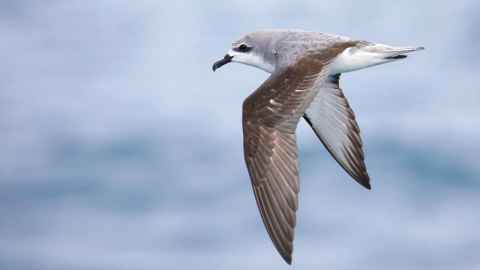For Tītī sake, turn off the lights
27 October 2022
Opinion: It's high time a seabird won Bird of the Year says Ariel-Micaiah Heswell, and why not give the Cook's Petrel the break it deserves?

Bird of the Year, the annual event organised by Forest & Bird to engage and increase in public awareness of New Zealand’s native birds, will close at 5pm on 30 October and if you haven’t voted already, you still have time to elect a bird, maybe even a seabird.
Well, it would be a first for seabirds, and why not? Okay, I confess to a conflict of interest here, helping BirdCare Aotearoa to manage this year’s campaign for the Cook’s petrel (Tītī). I elected to draw attention to this little seabird as my latest research involved exploring the impact of artificial lighting from New Zealand’s biggest city on the Cook’s petrel and other seabirds in the Gulf.
It is not a well-known fact, but Aotearoa New Zealand is a seabird hotspot having almost a quarter of the world’s seabird species breeding right here. More than a third of Aotearoa’s seabirds breed nowhere else in the world. The Haruaki Gulf next to Auckland city is full of a diverse array of seabirds having 27 seabird species ranging from little blue penguins, to prions, petrels, shearwaters, and gannets.
Artificial lighting (vehicle lights, bridge lights, building lights, street lighting and so on) can change animal behaviour, typically not to their benefit. Most research into the effects of artificial lighting on birds has focused on songbirds, particularly those on annual migration routes attracted to bright lights at night. But some seabirds are also active at night, and can also be attracted to bright lights, resulting in them colliding with fishing vessels, cruise ships, bridges and buildings, which is likely to leave them injured and at risk of starving as a result of grounding – crashing to the ground and being unable to get back on the wing.
In our recently published research we examined the toll light pollution is having on our seabirds in Tāmaki Makarau, by mapping the location of 356 seabirds that we knew had been disoriented by light and consequently crash-landing and grounding. We wanted to identify the locations especially prone to seabird groundings in the Auckland region, and for correlations between this seabird fallout and artificial lighting.
Of the 356 birds that had grounded about half (185) died from their injuries. Most groundings were found around the central business district, including areas such as Queen Street and the Sky Tower which also have a high intensity of light pollution. Cook’s petrel had the highest numbers of groundings in Auckland city due to light pollution, with a whopping 400 grounded across Auckland from 2018 to the present day.
To most people, the Cook’s petrel is perhaps not the most charismatic of bird species. It’s a small grey and white bird...but they are special little seabirds.
Other seabirds that commonly fell victim to light pollution included the grey-face petrel, the black petrel, the Buller’s shearwater, the fluttering shearwater, the common diving petrel, the white-faced storm petrel and the sooty shearwater.
To most people, the Cook’s petrel is perhaps not the most charismatic of bird species. It’s a small grey and white bird with a grey head and white-and-dark speckling on the forehead and crown, and no longer than 30cm. It does not have a melodious song, not the kind of call that has typically inspired poets to capture it in words, as the magpies inspired Denis Glover. They don’t “Quardle oodle ardle wardle doodle”, but Aucklanders can hear their “kek-kek-kek-kek-kek” calls at night when they are crossing over the city to feed in the Tasman Sea.
But they do have a sweet and spunky side to them, and are special little seabirds, endemic to Aotearoa, meaning that they only breed in Aotearoa. They breed on Little Barrier Island/Te-Hauturu-O-Toi, Great Barrier Island/Aotea and Codfish Island/Whenua Hou. These little seabirds can fly across the Pacific Ocean and back during winter. During the months of April-May many juvenile fledglings cross over the Auckland isthmus heading to their feeding grounds in the Tasman, which is when they when they are vulnerable to the bright lights of the city.
Auckland city is not a safe place for seabirds, which have been found grounded across the city as far south as Waiuku and as far north as Mangawhai. They even have been found grounded by lights along Piha and Muriwai.
Many of those found injured are brought to BirdCare Aotearoa, a rehabilitation facility where the team of staff and volunteers will nurse them back to health and release them at dusk at Te Henga (Bethells Beach) or Piha on Auckland’s west coast. But many, sadly, don’t make it because of injuries.
If you find a grounded seabird, report it to the SPCA and/or bring it to BirdCare Aotearoa. Also, we could all play our part by considering our own unnecessary light pollution, at least by dimming our lights at night and closing our curtains and blinds.
And, perhaps we could all give the Cook’s petrel a boost, by voting for it as Bird of the Year. It is high time that a seabird had the spotlight put on them, in a good rather than a disorientating way.
Ariel-Micaiah Heswall is a doctoral candidate studying seabird sensory ecology in the School of Biological Sciences, University of Auckland.
This article reflects the opinion of the author and not necessarily the views of Waipapa Taumata Rau University of Auckland.
This article was first published on Newsroom, For Tītī sake, turn off the lights, 27 October, 2022
Media contact
Margo White I Media adviser
Mob 021 926 408
Email margo.white@auckland.ac.nz